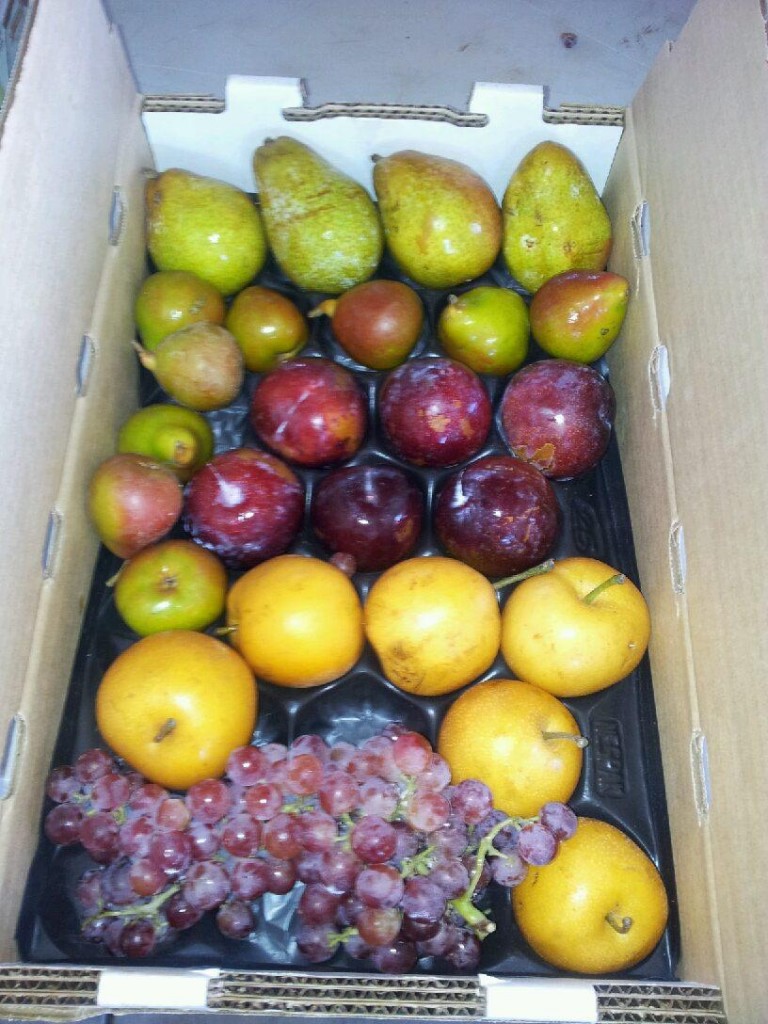This Week’s Fruit
Flavor Treat Pluot
One of our last stone-fruits of the season, the Flavor Treats are reddish-purple over tender, yellow flesh that’s extremely juicy. These pluots can be enjoyed for a few days if left on the counter. Don’t stack them though! If you’d like to enjoy them beyond 3-4 days you may want to set a few aside in the fridge.
Seckle Pears
A varietal that pre-dates the Bosc, the Seckel is much smaller in size and finds its origins near Philadelphia in the early 1800s. Also known as sugar pears, the Seckel is green with a dark-red blush or in some cases nearly all red. It’s extremely sweet with almost no acid and its fine flesh is very juicy. Ripe when wrinkled and yielding slightly near the stem. Pears will store well in the fridge once they’ve reached your optimal ripeness.
Warren Pears
This is Frog Hollow Farm’s signature pear and for good reason. Too difficult to grow for most farmers to consider it’s never caught on commercially but Farmer Al has never shied away from putting the time and effort into a fruit that tastes so good. It has a classic European texture, very soft and juicy with a silky sweetness that avoids the typical grittiness found in most pears. Ripe when wrinkled and yielding slightly near the stem. Pears store well in the fridge once they’ve reached your optimal ripeness.
Hosui Asian Pears
The Hosui is popular in both Japan and in California. They have a rougher,
thicker skin than other Asian pears with flesh that while still crunchy has a more melting mouthful, making the texture combination when eaten out of hand spectacular. Very juicy and sweet with a milder pear taste, their round shape and beautiful golden hue make them ideal for presentation with a distinctively Autumnal feel. These pears do fine on the counter for up to a week. To enjoy after a week, store in the fridge.
Flame Seedless Grapes
Firm, large, and sweet the Flame Seedless are one of the most popular varieties in North America. Enjoy these out of hand or try them in salads. Grapes can be enjoyed from the counter within a few days of receiving your box or placed in the fridge if you’d like to enjoy them further into the week.
A Note from Farmer Al
Dear CSA Members,
A couple of weeks ago I explained to you why we prune apricots in the late summer; it’s to avoid Eutypa infections. Eutypa is a fungus, always present (dormant) on apricot branches, which can become activated by rain and washed into “pruning cuts”, getting into the cambium layer of the bark and killing branches. The assumption is that it won’t rain until probably November, so prune now allowing the pruning cuts time to heal and seal off before it rains.
But just when you think you’re doing everything right, Mother Nature steps in and changes everything. We’ve just finished pruning 50% of our apricot trees and here comes the “freak” last day-ofsummer-storm, and drops a half inch of rain on our just pruned cots.
Plan B…brew up some tea; compost tea, of course! Our resident compost- meister Christophe wants to brew up some vermi-compost tea. This tea should be even more fungally dominant than our usual tea, and we’ll spray it on all the apricots which were pruned. The idea here is to populate the biosphere of the apricot branches with good fungus and bacteria which will out compete and overpower the Eutypa fungus, thus preventing the disease.
Elsewhere in the orchards the rain was a good thing, very good in fact. First, it gave us free water, saving us one, late- season irrigation. (Each time we irrigate it costs about $2000). Secondly, this rain did a really good job of activating all the microbes in the compost that we’ve been spreading for the past weeks and moving them into the soil where they will begin doing “their thing”, enlivening the soil and increasing the biological activity there.
The rain also cleaned the air from all the dust and smoke of recent weeks and the making everything brighter and more brilliant as we head into the beautiful autumnal light.


 Follow
Follow

